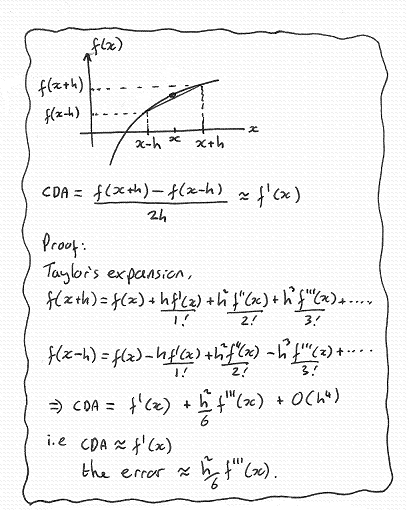http://cpp.gantep.edu.tr
C++ resources. Faculty of Engineering, University of Gaziantep
Last modified: Sat, 31 Oct 2009 12:23:17 +0200
Complete: ##################-- (90%)
Differentiation of a function f(x) |
1. The Central Difference Approximation (CDA) 2. The Richardson Extrapolation Method |
The derivative f'(x) of a function f(x) is simply the gradient of the function at a point x. Finding the derivative of a function analytically may be difficult and so a numerical solution may be necessary or simply convenient. The following sections describe two methods of differentiation, both are based on the approximation of the gradient of f(x) around a value x.
1. The Central Difference Approximation (CDA)
In the figure below, the gradient of the function at x is approximated by the line drawn from x-h to x+h. This is called the Central Difference Approximation (CDA). Intuitively this approximation looks right, and as h reduces in size the approximation should improve. Below the diagram is the proof from Taylor's expansion that the CDA does return the first derivative with an error of approximately h2/6 f'''(x); i.e. the error is proportional h2. The value of h should therefore be chosen to be small, however if it is too small then round-off errors will dominate the total error. The choice of h may therefore require some experimentation.
The CDA is implementated in the program below.
nmprimer-CDA.cpp: Central Difference Approximation (CDA) for the derivative of a function.
1: 2: 3: 4: 5: 6: 7: 8: 9: 10: 11: 12: 13: 14: 15: 16: 17: |
// Central Difference Approximation (CDA) for the derivative of a function f(x)
// For f(x) = x^4 the analytical solution is 4x^3 e.g. f'(3.5)=171.5
#include <iostream>
#include <iomanip>
using namespace std;
double f(double x) { return x*x*x*x; } // The function f(x)
int main() {
double x=3.5, h=0.001;
double CDA = (f(x+h)-f(x-h))/(2*h);
cout << setprecision(8) << fixed;
cout << "CDA = " << CDA << endl;
} |
CDA = 171.50001400 |
2. The Richardson Extrapolation Method
The Richardson Extrapolation Approximation (REA) provides a higher-order approximation, i.e. the truncation error is proportional to a higher power of h and so is much smaller for h<<1. The truncation error in the REA is approximately h4/30 f`````(x). You can prove this by constructing the REA using Taylor's expansion as performed above for the CDA.The REA is implementated in the program below.
nmprimer-REA.cpp: The Richardson Extrapolation Method for the derivative of a function.
1: 2: 3: 4: 5: 6: 7: 8: 9: 10: 11: 12: 13: 14: 15: 16: 17: |
// Richardson Extrapolation Aprroximation (REA) for the derivative of a function f(x)
// For f(x) = x^4 the analytical solution is 4x^3 e.g. f'(3.5)=171.5
#include <iostream>
#include <iomanip>
using namespace std;
double f(double x) { return x*x*x*x; } // The function f(x)
int main() {
double x=3.5, h=0.001;
double REA = (f(x-2*h)-8*f(x-h)+8*f(x+h)-f(x+2*h))/(12*h);
cout << setprecision(8) << fixed;
cout << "REA = " << REA << endl;
} |
REA = 171.50000000 |
Complete: ##################-- (90%)